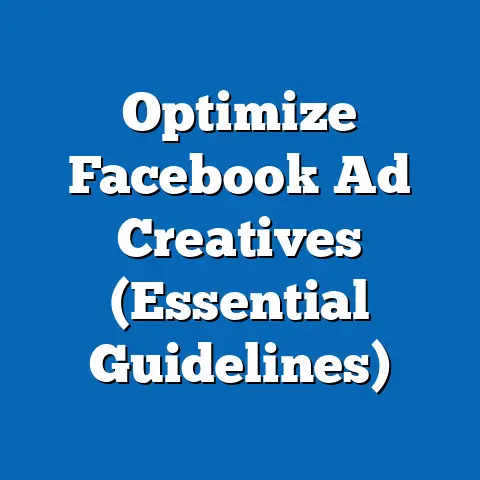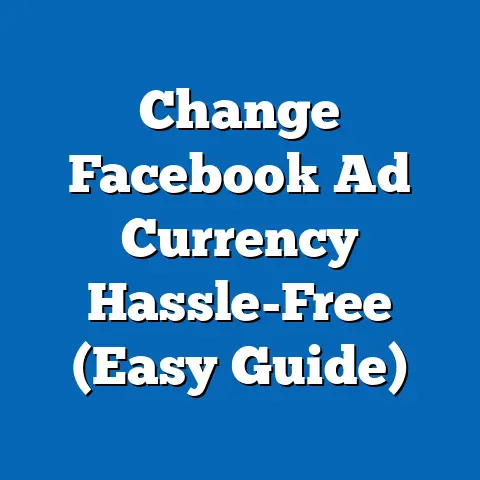Boost Facebook iOS Ads Performance (Proven Strategies Unveiled)
In the fast-evolving world of digital advertising, few challenges have sparked as much debate and urgency as optimizing Facebook ads for iOS users. With Apple’s introduction of App Tracking Transparency (ATT) in 2021, the digital marketing ecosystem was fundamentally disrupted, leaving advertisers scrambling to adapt to a new reality where user tracking is no longer a given. This seismic shift, driven by privacy concerns and regulatory changes, has disproportionately impacted platforms like Facebook, which historically relied on granular user data to deliver hyper-targeted ads.
Why does this matter? For businesses, the ability to effectively reach iOS users—who represent a significant and often high-value demographic—can mean the difference between a thriving campaign and a costly failure. The societal implications are equally profound, as these changes reflect a broader cultural shift toward data privacy and user empowerment, challenging the very foundation of digital advertising.
This article dives deep into the proven strategies for boosting Facebook iOS ads performance in a post-ATT world. We’ll explore the historical context of Apple’s privacy pivot, the defining characteristics of the iOS advertising landscape, and the broader implications for marketers and society. Backed by data, expert insights, and real-world case studies, this comprehensive analysis aims to equip advertisers with actionable solutions while unpacking the nuances of this complex challenge.
Historical Context: The Rise of Privacy and the Fall of Traditional Tracking
To understand the current state of Facebook iOS ads, we must first revisit the pivotal moment that reshaped the industry: Apple’s rollout of iOS 14.5 in April 2021. This update introduced ATT, a framework requiring apps to obtain explicit user consent before tracking their activity across other apps and websites. For a platform like Facebook, which depended heavily on Apple’s Identifier for Advertisers (IDFA) to build detailed user profiles, this was a game-changer.
Before ATT, advertisers could leverage IDFA to track user behavior with precision, enabling personalized ads and accurate attribution. However, with over 70% of iOS users opting out of tracking (according to a 2022 study by AppsFlyer), the data pool for targeting and measurement has drastically shrunk. This wasn’t just a technical hurdle; it was a cultural statement—Apple positioned itself as a champion of user privacy at a time when public skepticism of Big Tech was reaching a fever pitch.
The ripple effects were immediate. Facebook’s parent company, Meta, reported a projected $10 billion revenue loss in 2022 due to ATT’s impact, as stated in their Q4 2021 earnings call. Small and medium-sized businesses, which often lack the resources to pivot quickly, were hit hardest, struggling to maintain ad effectiveness. This historical pivot underscores a broader societal tension between technological innovation and individual rights—a tension that continues to shape digital advertising strategies today.
Defining Characteristics of the iOS Ads Landscape Post-ATT
The post-ATT iOS advertising landscape is defined by three core characteristics: limited data access, increased reliance on first-party data, and a shift toward privacy-compliant solutions. Each of these elements presents unique challenges and opportunities for advertisers on platforms like Facebook.
First, the drastic reduction in IDFA availability has crippled traditional targeting and attribution models. Where advertisers once had access to detailed behavioral data, they now face “blind spots” in understanding user journeys. According to a 2023 report by Adjust, iOS ad attribution accuracy dropped by nearly 40% in the first year post-ATT, forcing marketers to rethink how they measure success.
Second, the emphasis on first-party data—information collected directly from users through owned channels—has become a cornerstone of effective iOS advertising. Unlike third-party data, which is now heavily restricted, first-party data offers a privacy-compliant way to personalize ads. However, building robust first-party datasets requires time, trust, and strategic user engagement.
Finally, the rise of privacy-compliant tools, such as Apple’s SKAdNetwork (SKAN), has introduced new ways to measure ad performance without compromising user anonymity. While SKAN provides aggregated, delayed data on installs and conversions, it lacks the granularity of pre-ATT systems, leaving advertisers to navigate a steep learning curve. These characteristics collectively define a landscape that demands adaptability, creativity, and a willingness to embrace uncertainty.
Societal Implications: Privacy, Trust, and the Future of Advertising
The challenges of iOS ads performance extend beyond technical hurdles; they reflect deeper societal shifts in how we view privacy, technology, and corporate responsibility. Apple’s ATT framework didn’t emerge in a vacuum—it was a response to growing public concern over data misuse, exemplified by high-profile scandals like Cambridge Analytica in 2018. As users demand greater control over their digital footprints, platforms and advertisers must prioritize transparency to rebuild trust.
This shift has economic implications as well. While large corporations with vast resources can adapt to privacy changes through advanced tech stacks and diversified marketing channels, smaller businesses often struggle to keep up. A 2022 survey by the National Federation of Independent Business found that 62% of small business owners reported reduced ad ROI on Facebook following ATT, highlighting a potential widening gap between industry giants and smaller players.
Culturally, the move toward privacy-centric advertising may redefine how brands connect with audiences. Hyper-personalized ads, once the gold standard, are giving way to broader, context-based targeting that prioritizes user comfort over granular precision. This evolution challenges marketers to find new ways to engage without overstepping boundaries—a delicate balance that will shape the future of digital interactions.
Proven Strategies for Boosting Facebook iOS Ads Performance
Navigating the complexities of iOS advertising requires a multi-faceted approach. Below, we outline proven strategies that blend technical innovation, creative adaptation, and data-driven decision-making to optimize Facebook ads performance. These strategies are grounded in industry research, case studies, and expert recommendations.
1. Leverage First-Party Data for Personalized Targeting
With third-party data severely limited, first-party data has become the bedrock of effective iOS advertising. Brands can collect this data through website interactions, app engagements, customer surveys, and loyalty programs. For instance, encouraging users to sign up for newsletters or create accounts provides valuable insights while respecting privacy norms.
A 2023 case study by HubSpot revealed that businesses using first-party data for ad personalization saw a 25% increase in click-through rates (CTR) compared to generic campaigns. On Facebook, this means integrating tools like the Conversions API (CAPI) to track user actions directly from your website or app, bypassing iOS restrictions. By mapping customer journeys through owned channels, advertisers can create tailored audiences for campaigns, even in a data-scarce environment.
Implementation tip: Focus on value exchange—offer incentives like discounts or exclusive content to encourage users to share their data willingly. Transparency about data usage is key to maintaining trust. Additionally, segment audiences based on first-party insights to ensure relevance without relying on external tracking.
2. Optimize for SKAdNetwork and Aggregated Measurement
Apple’s SKAdNetwork is the primary mechanism for measuring iOS ad performance in a privacy-compliant way. While SKAN data is aggregated and delayed (often by 24-48 hours), it provides critical insights into installs and post-install events. Advertisers must optimize their campaigns to align with SKAN’s limitations, such as focusing on high-value conversion events within the 64 predefined options.
According to a 2023 report by Singular, brands that adapted their measurement frameworks to SKAN saw a 30% improvement in campaign attribution accuracy over those relying on outdated models. On Facebook, this involves configuring events in the Ads Manager to match SKAN parameters and prioritizing campaigns with clear, measurable outcomes like app installs or purchases.
Implementation tip: Collaborate with mobile measurement partners (MMPs) like Adjust or AppsFlyer to interpret SKAN data effectively. Test different event configurations to identify which conversions yield the most actionable insights. Patience is crucial—SKAN’s delayed reporting requires a longer-term view of performance.
3. Shift to Broad and Contextual Targeting
The era of hyper-targeted ads may be waning, but broad and contextual targeting offers a viable alternative for iOS users. Instead of relying on individual user data, focus on audience interests, demographics, and contextual signals like content engagement or device type. Facebook’s machine learning algorithms can still optimize delivery to relevant users, even with less granular input.
A 2022 experiment by Social Media Today found that broad targeting campaigns on Facebook achieved 85% of the reach of pre-ATT hyper-targeted ads, with only a modest increase in cost-per-acquisition (CPA). Contextual ads, such as those placed alongside relevant content or in specific groups, also resonate well with privacy-conscious users who value relevance over personalization.
Implementation tip: Use Facebook’s Lookalike Audiences based on first-party data to expand reach without invasive tracking. Test ad placements in high-engagement environments like Stories or Reels, where contextual relevance can drive interaction. Monitor performance metrics closely to refine audience parameters over time.
4. Enhance Creative and Messaging for Engagement
In a data-limited environment, the quality of ad creative becomes a critical differentiator. Compelling visuals, clear calls-to-action (CTAs), and authentic messaging can capture attention and drive conversions, even without precise targeting. iOS users, often skewed toward higher-income demographics, respond well to premium branding and value-driven content.
A 2023 study by Nielsen found that ads with strong creative elements outperformed data-driven targeting alone by 20% in terms of brand recall on mobile platforms. For Facebook iOS campaigns, this means prioritizing video content, which consistently garners higher engagement rates, and crafting messages that align with user values like sustainability or innovation.
Implementation tip: A/B test multiple creative variations to identify what resonates with your audience. Use dynamic ads to showcase products or services based on user interactions within your app or website. Incorporate user-generated content (UGC) to build authenticity and trust, especially among privacy-savvy iOS users.
5. Diversify Attribution Models Beyond Last-Click
Traditional last-click attribution models are ill-suited for the post-ATT landscape, where user journeys are obscured by privacy barriers. Advertisers must adopt multi-touch attribution (MTA) or media mix modeling (MMM) to understand the broader impact of their campaigns. These models account for various touchpoints, providing a holistic view of performance.
Meta’s own 2022 whitepaper on attribution highlighted that brands using MTA saw a 15% more accurate representation of ad impact compared to last-click models. For iOS campaigns, this involves integrating Facebook’s Aggregated Event Measurement (AEM) with offline data and other channels to piece together user behavior.
Implementation tip: Invest in analytics platforms that support cross-channel attribution, ensuring you capture data from email, organic search, and other touchpoints. Use incremental lift studies to measure the true effect of Facebook ads on conversions. Regularly reassess attribution windows to account for delayed SKAN reporting.
6. Test and Iterate with a Growth Mindset
The iOS advertising space is in constant flux, with Apple frequently updating its policies and tools. A growth mindset—focused on experimentation and learning—is essential for staying ahead. Testing different strategies, from ad formats to audience segments, allows advertisers to uncover what works in their specific context.
A 2023 case study by Adweek showcased a mid-sized e-commerce brand that increased iOS ad ROI by 35% through rigorous testing of over 50 campaign variables in a six-month period. On Facebook, this means leveraging tools like split testing and dynamic creative optimization to iterate quickly and scale successful approaches.
Implementation tip: Allocate a portion of your budget to experimental campaigns, even if initial results are uncertain. Use Facebook’s Campaign Budget Optimization (CBO) to distribute spend across high-performing ad sets automatically. Document learnings from each test to build a knowledge base for future efforts.
Comparative Analysis: iOS vs. Android Ads Performance on Facebook
While this article focuses on iOS, comparing performance dynamics with Android provides valuable context. Unlike iOS, Android’s ecosystem (primarily driven by Google) has not yet implemented sweeping privacy changes on the scale of ATT, though initiatives like Privacy Sandbox signal a similar trajectory. As a result, Android campaigns on Facebook retain access to more granular data, leading to higher attribution accuracy and lower CPAs.
A 2023 report by Branch found that Android campaigns achieved 20-30% lower CPAs compared to iOS across industries like gaming and e-commerce. However, iOS users often exhibit higher lifetime value (LTV), with Apple’s demographic skewing toward affluent, tech-savvy consumers. This trade-off means advertisers must balance short-term efficiency (Android) with long-term value (iOS).
The key takeaway? Strategies developed for iOS—such as first-party data reliance and creative optimization—can often be applied to Android with minor tweaks, preparing brands for future privacy changes on all platforms. Conversely, Android’s data-rich environment offers a testing ground for tactics that can be adapted to iOS constraints.
Technological and Economic Factors Shaping iOS Ads Performance
Technologically, the iOS ads landscape is shaped by Apple’s ongoing commitment to privacy, evidenced by updates like iOS 17’s enhanced tracking protections in 2023. Tools like SKAN 4.0, introduced in 2022, offer incremental improvements in measurement, but they still lag behind pre-ATT capabilities. Advertisers must invest in tech solutions—such as server-side tracking via CAPI—to bridge these gaps.
Economically, the high cost of iOS ad inventory reflects the platform’s premium user base. According to eMarketer, iOS CPMs (cost per thousand impressions) were 15% higher than Android in 2023, driven by competition for a smaller, privacy-protected audience. This economic reality underscores the need for efficiency-focused strategies like those outlined above.
Socially and culturally, the preference for privacy among iOS users aligns with broader generational trends. Millennials and Gen Z, who form a significant portion of iOS users, prioritize data control, as noted in a 2022 Pew Research Center study. Advertisers must adapt messaging to reflect these values, emphasizing transparency and user empowerment.
Nuances and Diversity Within the iOS User Base
Not all iOS users are the same, and assuming homogeneity risks ineffective campaigns. Geographic differences, for instance, influence opt-in rates for tracking—European users, shaped by GDPR, opt out at higher rates (80%+) compared to users in Asia-Pacific (around 60%), per AppsFlyer data. Device type also matters; iPad users may engage differently than iPhone users due to screen size and usage context.
Age and socioeconomic status add further layers of complexity. Older iOS users may prioritize privacy over personalization, while younger users might value relevance if trust is established. Advertisers must segment audiences thoughtfully, using first-party data to tailor experiences without overgeneralizing.
Implications for Marketers, Businesses, and Society
For marketers, mastering iOS ads performance is no longer optional—it’s a competitive necessity. Success requires a shift from data dependency to creative and strategic innovation, as well as investment in privacy-compliant tools. Businesses, especially SMEs, must allocate resources to upskill teams and adopt new technologies, even amidst budget constraints.
In the workplace, the rise of privacy-centric advertising may spur demand for roles like data privacy specialists and creative strategists. Companies that adapt quickly could gain a first-mover advantage, building trust with consumers while competitors lag behind.
Societally, the push for privacy in advertising reflects a broader rebalancing of power between individuals and corporations. While this empowers users, it also raises questions about digital equity—will smaller businesses be sidelined as costs rise? And how will reduced ad personalization impact user experiences? These questions remain open as the industry evolves.
Conclusion: Looking Ahead in an Uncertain Landscape
Boosting Facebook iOS ads performance in a post-ATT world is a complex but achievable goal. By leveraging first-party data, optimizing for SKAN, embracing broad targeting, enhancing creative, diversifying attribution, and adopting a test-and-learn mindset, advertisers can navigate the challenges of limited tracking while delivering impactful campaigns. The strategies outlined here are not static—they must evolve with Apple’s policies, user expectations, and technological advancements.
Looking forward, the trajectory of iOS advertising remains uncertain. Will Apple introduce even stricter privacy measures? How will Meta and other platforms innovate to counterbalance data loss? And what role will emerging technologies like AI play in bridging measurement gaps? While definitive answers are elusive, one thing is clear: adaptability will be the hallmark of success.
As we stand at the intersection of privacy and performance, the lessons learned from iOS ads today will shape the broader future of digital marketing. Advertisers who embrace this challenge with creativity and resilience will not only survive but thrive in an era where trust is the ultimate currency.






